People watch a news broadcast on a missile launch in Pyongyang, North Korea, Saturday, July 29, 2017. North Korean leader Kim Jong Un said Saturday the second flight test of an intercontinental ballistic missile demonstrated his country can hit the U.S. mainland, hours after the launch left analysts concluding that a wide swath of the United States, including Los Angeles and Chicago, is now in range of North Korean weapons. (AP Photo/Jon Chol Jin)
The Associated Press
PYONGYANG, North Korea (AP) - North Korean leader Kim Jong Un said Saturday the second flight test of an intercontinental ballistic missile demonstrated his country can hit the U.S. mainland, hours after the launch left analysts concluding that a wide swath of the United States, including Los Angeles and Chicago, is now in range of North Korean weapons.
The Korean Central News Agency said that Kim expressed "great satisfaction" after the Hwasong-14 missile reached a maximum height of 3,725 kilometers (2,314 miles) and traveled 998 kilometers (620 miles) before accurately landing in waters off Japan. The agency said that the test was aimed at confirming the maximum range and other technical aspects of the missile it says was capable of delivering a "large-sized, heavy nuclear warhead."
Analysts had estimated that the North's first ICBM on July 4 could have reached Alaska, and said that the latest missile appeared to extend that range significantly.
Immediately after the launch, U.S. and South Korean forces conducted live-fire exercises. South Korean Defense Minister Song Young-moo called for the deployment of strategic U.S. military assets - which usually means stealth bombers and aircraft carriers - as well as additional launchers of an advanced U.S. anti-missile system.
Japanese government spokesman Yoshihide Suga said the missile, launched late Friday night, flew for about 45 minutes - about five minutes longer than the first. The missile was launched on very high trajectory, which limited the distance it traveled, and landed west of Japan's island of Hokkaido.
The KCNA quoted Kim as saying that the launch reaffirmed the reliability of the country's ICBM system and an ability to fire at "random regions and locations at random times" with the "entire" U.S. mainland now within range. The agency said that the test confirmed important features of the missile system, such as the proper separation of the warhead and controlling its movement and detonation after atmospheric re-entry.
Kim said the launch sent a "serious warning" to the United States, which has been "meaninglessly blowing its trumpet" with threats of war and stronger sanctions, the KCNA said.
On the streets of Pyongyang, North Koreans welcomed the news of their country's latest missile test while state media broadcast images of a projectile launched into the night sky. Kim Jong Un was seen in the company of military commanders near a mobile missile launcher.
"I feel really confident. From now on, we will develop and have the strongest weapons, strategic weapons, so we can safeguard our sovereignty and independence, so that we can end up winning against the imperialists and against America," said Pak Gi Nam, a student. It is normal for North Koreans talking in front of TV cameras to stick to the official version of events.
The North Korean flight data was similar to assessments by the United States, South Korea and Japan.
David Wright, a physicist and co-director of the global security program at the Union of Concerned Scientists, said that if reports of the missile's maximum altitude and flight time are correct, it would have a theoretical range of at least 10,400 kilometers (about 6,500 miles). That means it could have reached Los Angeles, Denver or Chicago, depending on variables such as the size and weight of the warhead that would be carried atop such a missile in an actual attack.
President Donald Trump issued a statement condemning the missile test as a threat to the world, and rejecting North Korea's claim that nuclear weapons ensure its security. "In reality, they have the opposite effect," he said.
Trump said the weapons and tests "further isolate North Korea, weaken its economy, and deprive its people." He vowed to "take all necessary steps" to ensure the security of the U.S. and its allies.
Japanese Foreign Minister Fumio Kishida said he told U.S. Secretary of State Rex Tillerson in a phone call that the second missile test greatly increased the threat from Pyongyang. He said two sides agreed to consider all means necessary to exert the utmost pressure on North Korea. They reiterated calls for new sanctions and to work closely together with South Korea along with efforts by China and Russia.
China, meanwhile, urged its ally North Korea to abide by U.N. Security Council resolutions and halt any moves that could escalate tensions on the Korean Peninsula.
Washington and its allies have watched with growing concern as Pyongyang has made significant progress toward its goal of having all of the U.S. within range of its missiles to counter what it labels as U.S. aggression. There are other hurdles, including building nuclear warheads to fit on those missiles and ensuring reliability. But many analysts have been surprised by how quickly leader Kim Jong Un has developed North Korea's nuclear and missile programs despite several rounds of U.N. Security Council sanctions that have squeezed the impoverished country's economy.
Trump has said he will not allow North Korea to obtain an ICBM that can deliver a nuclear warhead. But this week, the Defense Intelligence Agency reportedly concluded that the North will have a reliable ICBM capable of carrying a nuclear weapon as early as next year, in an assessment that trimmed two years from the agency's earlier estimate.
The French Foreign Ministry condemned the launch and called for "strong and additional sanctions" by the United Nations and European Union. "Only maximal diplomatic pressure might bring North Korea to the negotiating table," the ministry said in a statement.
"This is a 4G threat: global, grave, given and growing," France's U.N. Ambassador Francois Delattre told The Associated Press. That's why we call for a firm and quick reaction including the adoption of strong additional sanctions by the Security Council."
A spokesman for Gen. Joseph Dunford, chairman of the Joint Chiefs of Staff, said that Dunford met at the Pentagon with the commander of U.S. forces in the Pacific, Adm. Harry Harris, to discuss U.S. military options in light of North Korea's missile test.
The spokesman, Navy Capt. Greg Hicks, said Dunford and Harris placed a phone call to Dunford's South Korean counterpart, Gen. Lee Sun Jin. Dunford and Harris "expressed the ironclad commitment to the U.S.-Republic of Korea alliance," Hicks said, referring to the U.S. defense treaty that obliges the U.S. to defend South Korea.
Abe, too, said Japan would cooperate closely with the U.S., South Korea and other nations to step up pressure on North Korea to halt its missile programs.
The Hwasong 14 ICBM test-fired earlier this month was also launched at a very steep angle, a technique called lofting, and reached a height of more than 2,500 kilometers (1,550 miles) before splashing down in the ocean 930 kilometers (580 miles) away. Analysts said that missile could be capable of reaching most of Alaska or possibly Hawaii if fired in an attacking trajectory.
South Korea's Joint Chiefs of Staff said the missile was launched from North Korea's northern Jagang province near the border with China. President Moon Jae-in presided over an emergency meeting of the National Security Council, which called for an emergency meeting of the U.N. Security Council and stronger sanctions on North Korea.
July 27 is a major national holiday in North Korea called Victory in the Fatherland Liberation War Day, marking the day when the armistice was signed ending the 1950-53 Korean War. That armistice is yet to be replaced with a peace treaty, leaving the Korean Peninsula technically in a state of war.
___
Yamaguchi reported from Tokyo. Associated Press writers Robert Burns and Darlene Superville in Washington, Kim Tong-hyung and Hyung-jin Kim in Seoul, South Korea, Edith Lederer at the United Nations and Elaine Ganley in Paris contributed to this report.
A man walks in front of a public TV screen broadcasting news of North Korea's test-firing of its second intercontinental ballistic missile, in Tokyo Saturday, July 29, 2017. North Korea on Friday test-fired its second intercontinental ballistic missile, which flew longer and higher than the first according to its wary neighbors, leading analysts to conclude that a wide swath of the U.S., including Los Angeles and Chicago, is now within range of Pyongyang's weapons. The ticker above reads: "North Korea fired ICBM missile." (AP Photo/Eugene Hoshiko)
The Associated Press
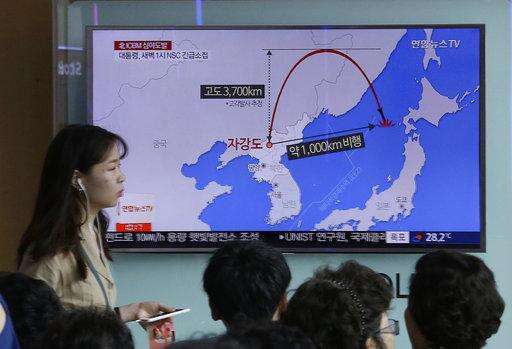
People sit in front of a TV screen showing a news program reporting about North Korea's missile firing, at Seoul Railway Station in Seoul, South Korea, Saturday, July 29, 2017. North Korea on Friday test-fired its second intercontinental ballistic missile, which flew longer and higher than the first according to its wary neighbors, leading analysts to conclude that a wide swath of the U.S., including Los Angeles and Chicago, is now within range of Pyongyang's weapons. (AP Photo/Ahn Young-joon)
The Associated Press
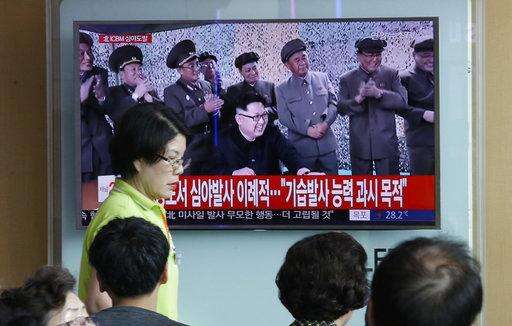
A TV news program shows a file image of North Korean leader Kim Jong Un, at Seoul Railway Station in Seoul, South Korea, Saturday, July 29, 2017. North Korea on Friday test-fired its second intercontinental ballistic missile, which flew longer and higher than the first according to its wary neighbors, leading analysts to conclude that a wide swath of the U.S., including Los Angeles and Chicago, is now within range of Pyongyang's weapons. The signs read: "North Korea launched a missile at midnight." (AP Photo/Ahn Young-joon)
The Associated Press
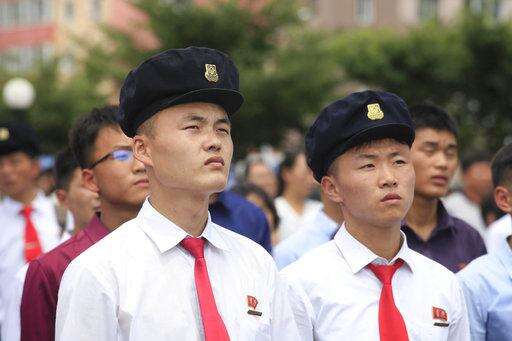
People watch a news broadcast on a missile launch in Pyongyang, North Korea, Saturday, July 29, 2017. North Korean leader Kim Jong Un said Saturday the second flight test of an intercontinental ballistic missile demonstrated his country can hit the U.S. mainland, hours after the launch left analysts concluding that a wide swath of the United States, including Los Angeles and Chicago, is now in range of North Korean weapons. (AP Photo/Jon Chol Jin)
The Associated Press
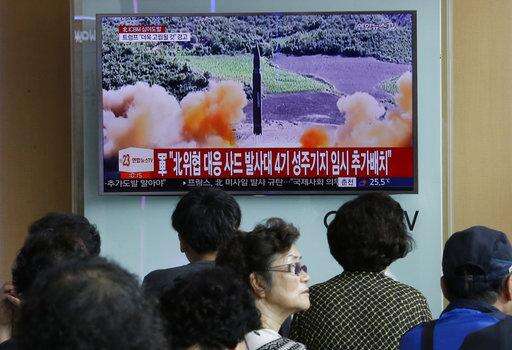
People watch a TV news program showing a file image of a missile being test-launched by North Korea, at Seoul Railway Station in Seoul, South Korea, Saturday, July 29, 2017. North Korea on Friday test-fired its second intercontinental ballistic missile, which flew longer and higher than the first according to its wary neighbors, leading analysts to conclude that a wide swath of the U.S., including Los Angeles and Chicago, is now within range of Pyongyang's weapons. The signs read: "The deployment of an advanced U.S. missile defense system called THAAD." (AP Photo/Ahn Young-joon)
The Associated Press
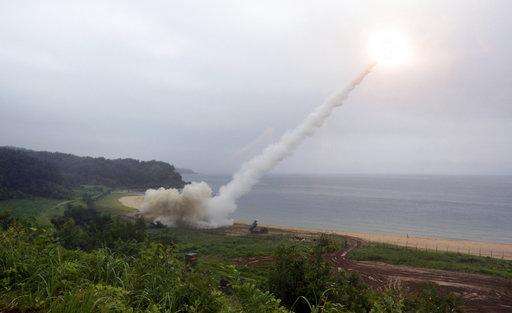
In this photo provided by South Korea Defense Ministry, U.S. Army Tactical Missile System fires a missile during the combined military exercise between the U.S. and South Korea against North Korea at an undisclosed location in South Korea, Saturday, July 29, 2017. North Korean leader Kim Jong Un said Saturday the second flight test of an intercontinental ballistic missile demonstrated his country can hit the U.S. mainland, hours after the launch left analysts concluding that a wide swath of the United States, including Los Angeles and Chicago, is now in range of North Korean weapons. (South Korea Defense Ministry via AP)
The Associated Press

In this photo provided by South Korea Defense Ministry, South Korea's Hyunmoo II Missile system fires a missile during the combined military exercise between the U.S. and South Korea against North Korea at an undisclosed location in South Korea, Saturday, July 29, 2017. North Korean leader Kim Jong Un said Saturday the second flight test of an intercontinental ballistic missile demonstrated his country can hit the U.S. mainland, hours after the launch left analysts concluding that a wide swath of the United States, including Los Angeles and Chicago, is now in range of North Korean weapons. (South Korea Defense Ministry via AP)
The Associated Press
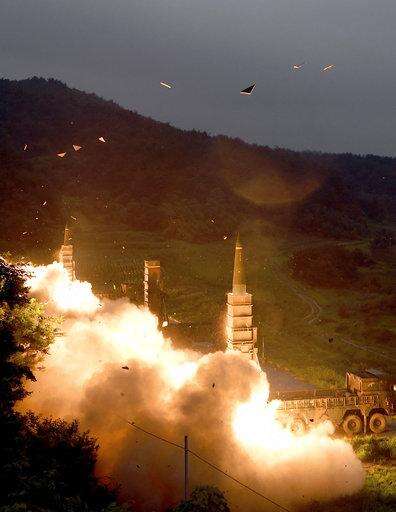
In this photo provided by South Korea Defense Ministry, South Korea's Hyunmoo II Missile system fires missiles during the combined military exercise between the U.S. and South Korea against North Korea at an undisclosed location in South Korea, Saturday, July 29, 2017. North Korean leader Kim Jong Un said Saturday the second flight test of an intercontinental ballistic missile demonstrated his country can hit the U.S. mainland, hours after the launch left analysts concluding that a wide swath of the United States, including Los Angeles and Chicago, is now in range of North Korean weapons. (South Korea Defense Ministry via AP)
The Associated Press
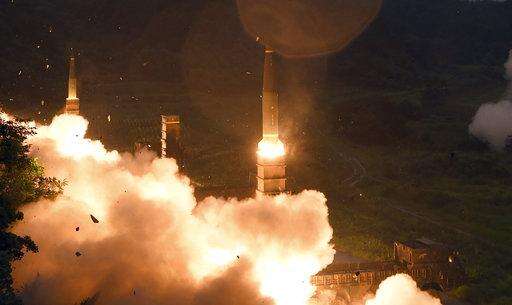
In this photo provided by South Korea Defense Ministry, South Korea's Hyunmoo II Missile system fire missiles during the combined military exercise between the U.S. and South Korea against North Korea at an undisclosed location in South Korea, Saturday, July 29, 2017. North Korean leader Kim Jong Un said Saturday the second flight test of an intercontinental ballistic missile demonstrated his country can hit the U.S. mainland, hours after the launch left analysts concluding that a wide swath of the United States, including Los Angeles and Chicago, is now in range of North Korean weapons. (South Korea Defense Ministry via AP)
The Associated Press

In this photo provided by South Korea Defense Ministry, South Korea's Hyunmoo II Missile system, left, and U.S. Army Tactical Missile System, right, fire missiles during the combined military exercise between the two countries against North Korea at an undisclosed location in South Korea, Saturday, July 29, 2017. North Korean leader Kim Jong Un said Saturday the second flight test of an intercontinental ballistic missile demonstrated his country can hit the U.S. mainland, hours after the launch left analysts concluding that a wide swath of the United States, including Los Angeles and Chicago, is now in range of North Korean weapons. (South Korea Defense Ministry via AP)
The Associated Press
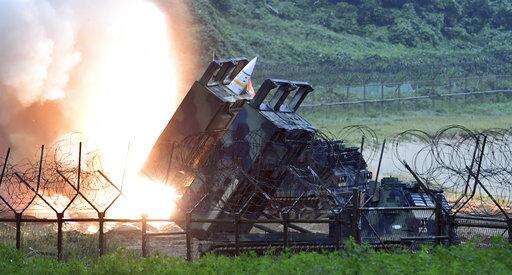
In this photo provided by South Korea Defense Ministry, U.S. Army Tactical Missile System fires a missile during the combined military exercise between the U.S. and South Korea against North Korea at an undisclosed location in South Korea, Saturday, July 29, 2017. North Korean leader Kim Jong Un said Saturday the second flight test of an intercontinental ballistic missile demonstrated his country can hit the U.S. mainland, hours after the launch left analysts concluding that a wide swath of the United States, including Los Angeles and Chicago, is now in range of North Korean weapons. (South Korea Defense Ministry via AP)
The Associated Press
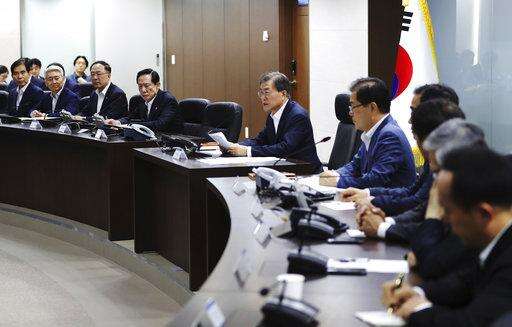
South Korean President Moon Jae-in, center, presides over a meeting of the National Security Council at the presidential Blue House in Seoul, South Korea, early Saturday, July 29, 2017. North Korea test-fired on Friday what the U.S. believes was its second intercontinental ballistic missile, which flew longer and higher than its first ICBM launched earlier this month, officials said. (Yonhap via AP)
The Associated Press
South Korean President Moon Jae-in, right, speaks as he presides over a meeting of the National Security Council at the presidential Blue House in Seoul, South Korea, early Saturday, July 29, 2017. North Korea test-fired on Friday what the U.S. believes was its second intercontinental ballistic missile, which flew longer and higher than its first ICBM launched earlier this month, officials said. (Yonhap via AP)
The Associated Press
South Korean President Moon Jae-in speaks as he presides over a meeting of the National Security Council at the presidential Blue House in Seoul, South Korea, early Saturday, July 29, 2017. North Korea test-fired on Friday what the U.S. believes was its second intercontinental ballistic missile, which flew longer and higher than its first ICBM launched earlier this month, officials said. (Yonhap via AP)
The Associated Press
People watch a news broadcast on a missile launch in Pyongyang, North Korea, Saturday, July 29, 2017. North Korean leader Kim Jong Un said Saturday the second flight test of an intercontinental ballistic missile demonstrated his country can hit the U.S. mainland, hours after the launch left analysts concluding that a wide swath of the United States, including Los Angeles and Chicago, is now in range of North Korean weapons. (AP Photo/Jon Chol Jin)
The Associated Press
People react while watching a news broadcast on a missile launch in Pyongyang, North Korea, Saturday, July 29, 2017. North Korean leader Kim Jong Un said Saturday the second flight test of an intercontinental ballistic missile demonstrated his country can hit the U.S. mainland, hours after the launch left analysts concluding that a wide swath of the United States, including Los Angeles and Chicago, is now in range of North Korean weapons. (AP Photo/Jon Chol Jin)
The Associated Press
People watch a news broadcast on a missile launch in Pyongyang, North Korea, Saturday, July 29, 2017. North Korean leader Kim Jong Un said Saturday the second flight test of an intercontinental ballistic missile demonstrated his country can hit the U.S. mainland, hours after the launch left analysts concluding that a wide swath of the United States, including Los Angeles and Chicago, is now in range of North Korean weapons. (AP Photo/Jon Chol Jin)
The Associated Press
People react while watching a news broadcast on a missile launch in Pyongyang, North Korea, Saturday, July 29, 2017. North Korean leader Kim Jong Un said Saturday the second flight test of an intercontinental ballistic missile demonstrated his country can hit the U.S. mainland, hours after the launch left analysts concluding that a wide swath of the United States, including Los Angeles and Chicago, is now in range of North Korean weapons. (AP Photo/Jon Chol Jin)
The Associated Press